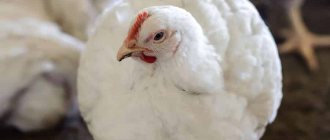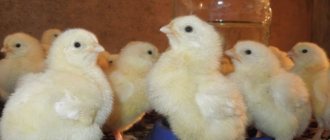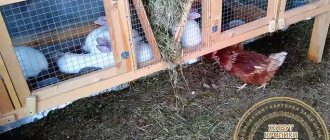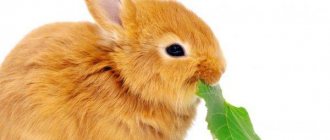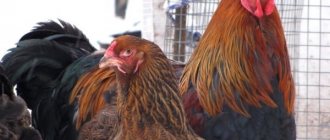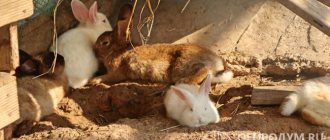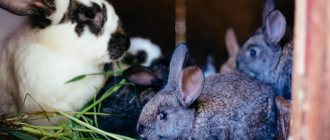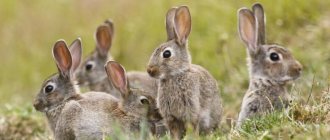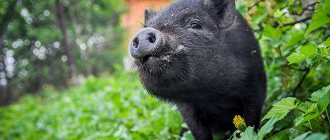Livestock » Rabbits
1
2960
Article rating
Kira Stoletova
The stability of the immunity of wild animals, their active growth and survival are the result of chaotic mating. This also applies to lagomorphs. Every experienced farmer knows that crossing rabbits is an activity that requires special control and knowledge in this area.
Crossing rabbits of different breeds
Some variations of this procedure help animals become stronger and more productive. In addition, industrial breeding involves the systematic use of crossbreeding methods to maintain the normal viability of not only individual individuals, but also entire breeds.
What you need to know about crossing
To obtain highly productive animals, the best rabbits are selected for the breeding herd.
It is worth giving preference to breeding representatives of the breed. It is recommended to choose Flanders as an improver; they have the highest live weight.
Before you crossbreed, you need to familiarize yourself with the basics of genetics so as not to get bad animals. Otherwise, rabbits may not inherit productive qualities from the maternal or paternal line.
Crossing can be industrial and introductory. The first is intended to improve the positive traits that the breed possesses. The introductory is used to eliminate the following flaws:
- small live weight;
- low fertility;
- the lethal yield does not have the required percentage.
What else you need to know
When improving the herd using new blood or breeding “in-house”, the farmer should follow a few more important rules. Thus, it is believed that the following cannot be used as producers:
- rabbits older than 3-5 years;
- rabbits who have eaten their droppings at least once;
- rabbits who have had a miscarriage at least once;
- rabbits over 3 years old.
It is best to select female rabbits for crossing with the widest rear possible. Low-milk rabbits must be discarded. In such animals, the cubs slowly gain weight after giving birth.
Downy breeds of rabbits
Rabbit fluff is an excellent raw material for light industry. It is not inferior in thickness to goat and sheep, has greater heat resistance, and is also very durable. It is believed that rabbit fluff has healing properties for radiculitis and neuralgia. Along with the growing popularity, interest in breeding downy breeds of rabbits is also growing. Turkey is considered the homeland of downy rabbits, from where they came to Europe at the beginning of the 17th century. The productivity of downy rabbits depends on many factors - nutrition, living conditions, down collection techniques, the age of the rabbit and the time of year.
Angora down rabbit
Angora downy rabbit
The rabbits got their name from the similarity of the fluff to the fur of the Angora goat. It is believed that these rabbits came to Europe from Turkey and immediately became fashionable pets for wealthy nobility. These cute playful creatures, similar to a fluffy ball, are still popular not as pets. The live weight of these rabbits is 3 kg, body length, chest circumference behind the shoulder blades. The fertility of females is low - 6 - 8 rabbits, which do not have high growth rates. They reach a two-kilogram weight only by 6 months. They are demanding in their conditions of detention - spacious cages, warm and dry are required, and regular haircuts are also required.
White fluffy bunny
White downy rabbit
A breed of downy rabbits obtained by domestic breeders by crossing Angora rabbits with local low-productive downy rabbits. The average weight of this breed is 4 kg, body length is 54 cm. Strong constitution, strong bones. A distinctive feature is the absence of tassels on the ears. On average 7 rabbits are born. The breed has a high productivity rate - 300-750 grams of fluff are obtained from one rabbit per year, and up to 1 kg from female rabbits. The delicate down of this breed is elastic, light and durable. In addition, rabbits are hardy and acclimatize well.
Here, in general, are all the main breeds of rabbits. There are also decorative breeds of rabbits, but they are mainly kept simply as pets, and not as industrial animals for meat, fluff or skin. To breed rabbits at home, I advise you to choose breeds of rabbits that are easy to maintain and then your farm, your rabbit farm will be profitable, even if not in monetary terms, but you will get yours from them. It is worth saying that little can be more important than the choice of breed. In addition, this article showed you the breeds of rabbits with photographs and you could clearly look at them.
Brief description of the meat direction
Raising rabbits can serve several purposes. Today, animals have been bred that produce high-quality meat products, with decent weight and fatness. There are downy breeds with a special coat, as well as mixed types, from which two types of products are obtained at once. However, such animals in the aggregate are inferior to breeds focused on a specific type of product.
Meat animals have the following indicators:
- young animals grow quickly;
- rapid gain of live weight;
- large size at birth;
- high survival rate;
- fertility;
- rapid physiological maturity.
The meat category is characterized by decent weight, the average is 5 kilograms, but larger individuals are also found. Animals have a well-developed immune system, which allows them to practically not get sick. Another advantage is the high level of adaptation to unfavorable climatic conditions, in particular frost.
What breeds exist
Soviet chinchillas
Refers to domestic breeds that have received high marks from foreign livestock breeders. The goal of the breeding work was to obtain animals with down and meat production with the same indicators of the highest quality in both cases, with an additional advantage being large weight.
The breed is adapted to the climate of the middle zone, which developed there initially. Chinchillas can be grown in any climatic zone of the Russian Federation. The animals are fertile, the predominant color is blue.
An adult male gains weight of 5 kg, the female is somewhat lighter. One female rabbit produces about 8 rabbits. The young animals are early maturing and by the 16th week they can gain a weight of 4 kg. The percentage of slaughter yield is 60.
White giants
They are one of the most popular meat breeds. Young animals are characterized by rapid weight gain. The animals have a calm, friendly character. The breed can be considered ancient; the first mentions date back to the 19th century.
The animals have an elongated body, with a developed dense thoracic region. The head, when compared with the body, is small. An adult rabbit weighs more than 5 kg, the highest figure is 8 kg.
Animals do not gain marketable weight quickly, but this can be compensated for by a very strong immune system, undemanding conditions and endurance. The breed is prolific, with a slaughter yield of 83%.
Gray giants
They occupy one of the first places in popularity among domestic breeders. Giants are unpretentious and quickly gain marketable mass. Body with well-developed muscles. The breed is characterized by high mobility; female rabbits are excellent mothers. The percentage of slaughter yield is more than 80.
Poltava silver
Belongs to domestic breeds. Animals were bred in the middle of the 20th century simultaneously in two regions near Poltava and Tula. The breed is characterized by a powerful build, large chest and neat head. Young animals are distinguished by their vitality and endurance. On average, an adult animal weighs 4.5 kg, the upper figure is 6 kg.
The breed is prolific - up to 8 rabbits can be produced from one female rabbit. Young animals can gain marketable weight in the shortest possible time. The breed is considered the best for raising for meat.
Vienna Blue
Austria is considered the birthplace of animals. Breeders used the Moravian and Flemish breeds to create new animals. The resulting rabbits cannot boast of considerable size, but are capable of gaining slaughter weight in a short time. The breed is suitable for producing meat and fur products.
On average, an adult rabbit weighs up to 5 kg. One female produces approximately 9 rabbits. The young animals are early maturing and very healthy. Diseases in rabbits are the exception rather than the rule. The Vienna Blue has a high adaptation to climatic conditions at the genetic level. Any region is suitable for growing them.
Rex
French breeders worked on animals in the 20th century. The breed cannot be called fertile and capable of gaining enormous mass. The average weight is 4 kg. The Constitution is not distinguished by its consistency and strength. The skeleton is thin-boned, the sternum is narrow. Young animals are able to gain weight of 2.5 kg by 16 weeks. There are approximately 5 rabbits in one litter.
All these not very good characteristics can be compensated by the excellent meat products that are obtained from Rex. It is dietary, tender, tasty, the fat content is insignificant. Animals are also valued for high-quality skins.
Butterflies
They belong to the Belarusian breeds with good fertility indicators. At least 8 rabbits are produced from one female. An adult animal gains weight of 4.5 kg.
Inbreeding
Closely related matings of animals on a small farm are considered unacceptable. Crossing rabbits of different breeds for meat (both to improve its quality and to increase quantity) is successful in most cases. Most likely, even a novice farmer will be able to improve the livestock in this way. The only thing is that an entrepreneur of such specialization needs to try to avoid inbreeding. Rabbits and rabbits for crossing should be taken from different litters from distantly related parents.
On small farms, inbreeding is a very dangerous phenomenon. Its negative consequences are:
- slow development of rabbits;
- sickness of the offspring;
- inability to reproduce.
An interesting fact is that it was through inbreeding that some currently popular breeds of rabbits were developed, for example, the same white giant. However, it is, of course, unlikely that it will be possible to obtain a new breed on a small farm and in the absence of certain knowledge and skills from the farmer. He will cause irreparable harm to his flock. It is believed that producers on a farm need to be changed at least once every 3-4 years. At the same time, new rabbits for reproduction should be purchased externally.
Who to choose for improvement
Thus, for absorptive crossbreeding, the farmer will first need to purchase several purebred rabbits. But which animals are best suited for this? In most cases, farmers choose white and gray giants to improve herd productivity. The offspring of such rabbits in outbred females are born very strong and quite large.
It is also believed that Flanders are very good for improving the herd on a farm. Crossing rabbits for meat (to subsequently obtain a large amount of it) is often carried out using rexes.
That is, rabbits of large breeds are best suited for absorption crossing. In the herd itself, of course, you need to choose the healthiest queens. Of course, only the largest females are suitable for this purpose. For further crossbreeding from half-blooded litters, of course, you also need to select the strongest, most active and healthy individuals.
What breeds of rabbits can be crossed with each other?
When choosing breeds for mating, try to avoid experiments. To say a new word in rabbit breeding, you need to be a professional with many years of experience in crossing. The easiest way is to consult reference books or find out the best combinations at the nursery where you are going to buy animals.
Among the popular breeds, pairs of males and females are identified, which give the best results. This is for example:
- Soviet chinchilla and White giant;
- Californian and Viennese blue;
- Black-brown and New Zealand.
Do not mate downy or furry breeds of rabbits. As a result of crossing, weak or non-viable offspring are born.
Varieties of crossing techniques
Crossing rabbits is not a monotonous process at all, as people far from farming might imagine. What matters is both the procedure itself and the choice of two animals - a male and a female. The quality of the offspring will depend on this, which is the growth rate of the individual and its weight. In addition, the baby rabbit is endowed with fur, which also has a price. But it is not difficult to benefit from all these breeding features only if certain conditions are met. And the first such condition is the use of certain types of crossbreeding as necessary.
Today, several types of crossing are known, which are used both at home and in industry. These include:
- introductory crossing;
- absorption crossing;
- industrial population increase;
- factory methods;
- variable and chaotic mating.
The main feature of crossing rabbits of different breeds is to obtain a healthy, high-quality litter. Which method is more effective depends largely on what breeds are used, as well as the purpose of the procedure itself. In addition, selection does not stand still, and recently a three-line crossing was reproduced in Hungary. The crossed specimen itself was named “White Pearl”.
Characteristics of the breed White Pearl has high growth rates as well as productivity. A female rabbit of this breed is capable of giving 4-5 litters per year. In addition, she feeds offspring of 30-32 heads in 42 days. By this time, the rabbits reach a weight of 2.5-2.7 kg.
Introductory procedure
The introductory procedure is one of the most popular and effective, especially in cases of urgent need to save the brood from extinction. Such problems often arise due to the fact that rabbits breed in a herd in which there are family ties. The farmer's inaction will quickly deteriorate the herd, making it weak and dying out. One easy way to fix this is to create an introduction. This is the procedure for mixing two bloods through mating:
- improving female and improving male;
- half-blooded female and upgradeable male;
- breeding in "oneself".
Rabbits that are bred by this method of crossing can have good performance:
- increase in live weight;
- acceleration of age for slaughter;
- precocity;
- reproductive abilities;
- milkiness.
In addition, some farms use “induction” to obtain wool. This method allows you to make it the highest quality and most expensive. The thicker and smoother it is, the higher the price. But such rabbits are bred very rarely. More often than not, the goal of livestock producers is to increase resilience.
A popular example of this procedure is the mixing of the White Giant and the Soviet Chinchilla. Much is known about the resulting offspring. The hares resulting from this experiment had a large percentage of meat from the carcass, good skin and vitality.
Features of industrial crossing
The answer to the question of which breeds of rabbits can be crossed depends on the genetic characteristics of the breeds themselves, as well as on the requirements and characteristics stated by the breeders. Many of them are used for industrial crossbreeding, which is intended to increase the benefit, and therefore the profit, of the bred individuals, so the first thing a breeder can do is to correctly follow the recommendations of breeders, although some of them can be contradictory.
The answer to the question of which selection of males and females of individual breeds will produce high-quality offspring should be sought in reference materials. A rabbit compatibility chart can also help.
| Rabbit | Crawl |
| White giant | Soviet chinchilla |
| Gray giant | Silver |
| Soviet chinchilla | Vienna blue |
| Californian | Black-brown |
| New Zealand | White giant |
| Black-brown | Californian |
| Vienna Blue | New Zealand |
All these crossbreeding options are an excellent chance for every farmer to increase his own profit from breeding. The rabbits resulting from such a mixture of blood will have high productivity rates. In addition, it is forbidden to experiment on your own. All possible types of tests were carried out repeatedly and the chance of “discovering” a new high-quality cross is close to zero, especially if an inexperienced farmer decided to do this.
The need to use other crossing methods
Other crossing methods are simpler and depend little on the individual (except for complex factory crossing). Only the variable procedure has some features that every farmer should understand. This method is used to increase profits after certain results of industrial crossing. For the crossing itself, the best female rabbit is selected (obtained from an industrial method or left for posterity) and mixed with the paternal and maternal breeds alternately.
The popular question among people, what kind of hares will be obtained by crossing white and black rabbits, is also associated with some selection features. White and black animals can produce grey, white or black rabbits. It all depends on genetic accuracy. In addition, the quality of animal wool will depend on how “nature” decides. But the task is simplified, since with the help of knowledge about some laws of genetics it is possible to calculate the external characteristics of the offspring with an accuracy of 95-98%.
Domesticated hares gradually lose the characteristics of their breed and require its restoration. In addition, each rabbit deteriorates her productivity indicators very quickly. The task is still the same: improving the breed that this or that male can produce. The resulting litter is kept separately from the livestock, females are selected and later crossed with other males of the improving breed. The most favorable age for crossing is from -5 months after birth.
It is necessary to carry out the crossing in time, because with age the female rabbit becomes fat and becomes unprofitable for further breeding.
Varieties of crossing methods
What are the features of mating rabbits at home for beginners? At the hunting stage, the female rabbit is immediately ready for mating. The process itself is short-lived; after sexual intercourse, the male lies on his side and makes characteristic sounds. After fertilization, it must be removed from the rabbit, since males are aggressive towards the fertilized individual.
If the farmer doubts the positive result, then after 5 days the procedure is repeated. If the female does not want this male, then she is placed with another. Artificial insemination is the most effective. The first stage passes without a doubt, individuals happen, and when the male covers her, the seed is collected in a container, and then fertilization is carried out using a syringe.
Many people are interested in the questions of why female rabbits do not walk and whether it is possible to mate animals in the cold. Animals can be bred even in rooms without heating. However, in severe frosts, it is advisable not to skimp on electricity. The main condition is to avoid drafts, as rabbits react negatively to them and can get sick. The cages should not be damp. Reproduction in cold weather in rabbits occurs according to the standard method. It is rare, but it happens that there is only one baby in a litter, which is determined by the structure of the body. To eliminate such troubles, lamps must be built into the premises so that the daylight hours last 16 hours.
Culling individuals from the herd
The selection of animals for mating must be carried out constantly. This is done during the period when the rabbits are separated from their mother. The strongest individuals are selected, with maximum manifestations of the desired traits. Pay attention to:
- fur condition;
- coloring;
- health;
- characteristics of the parents.
Rabbits are definitely not suitable for mating:
- patients, regardless of age and natural characteristics;
- rabbits and female rabbits that are over 3 years old;
- females who have suffered miscarriages;
- mother rabbits with aggressive behavior towards offspring;
- female rabbits who did not lay eggs after two matings;
- low-fertility females, with litters of less than 5 cubs.
Animals with bony hindquarters should not be used for breeding, since this is a dominant trait and will be passed on to the offspring, not being favorable or desirable.
By breeding rabbits, paying attention to the quality of the breed, properly organizing breeding and maintaining the characteristics of the genome of your herd, you will achieve excellent results and high profits in commercial breeding. It is important to properly organize housing, nutrition and care for the health of animals. A timely flow of blood will help maintain good meat characteristics of rabbits.
How do decorative individuals reproduce?
Such rabbits produce on average 6 litters annually. This process is preserved due to wild conditions, where littering is much more frequent. When breeding on a farm, the offspring is kept in almost constant quantities, so you can keep a lot of rabbits. To speed up mating, it is advisable to plan it for the summer. To familiarize partners, you need to place it on the floor. The first litter of this species should occur at 8 months of age.
Decorative rabbits
Producer males are used for no more than 5 years to continue the breed. The effectiveness of the process is checked after half a month. The rabbit is held by the rump and touched. The female's pregnancy is determined by the sensation of peas in the lower abdomen. The rabbits are born a month later. You should not expect more than 5 children from a decorative variety, unlike the standard breed, which produces up to 15 children. How old can the producers be?
These animals live on average 10 years. After 6-7 years, there is a decline in sexual activity. The mammary glands begin to atrophy, so milk production decreases significantly. The female becomes inactive and also prone to obesity. She can also crush her children. Births, accordingly, are becoming less and less common.
However, selection based on age is rare on the farm. As a rule, individuals drop out after 7 births, the reasons being infertility, illness and loss of milk. With positive reproduction, males, which have a high fertility rate, are used for five years. The remaining animals are only good for 3 years. Breeding these cute animals does not bring any difficulties. However, to obtain high-quality offspring, you need to take seriously the selection of individuals for mating, avoid family ties among animals, and also do not forget about proper maintenance.
Crossing different breeds of rabbits - on video:
Features of rabbit breeding
What breeds of rabbits can be crossed with each other and how does selection occur? The selection of breeding rabbits is carried out according to the following criteria:
- Rabbits up to the third litter of females are suitable for offspring.
- The selection of sires begins from the moment the children are born. Each litter contains both weak and large children. The last option is the most optimal candidate for continuing the tribe.
- Farmers look at the individual’s weight, coat, body structure and mobility.
- Culling should be done after a couple of matings. You should not take males as breeders who cannot fertilize a female in every second case. Females also need to be selected. Rejected are those individuals that bore fewer than four children in a pair of litters consecutively. Females that eat their babies are also not suitable. High milk production - shows how good the productivity of an individual is.
- It is customary for a farmer to have at least a couple of breeding rabbits. They are characterized by sexual activity, and frigid individuals are removed.
Advantages and disadvantages
Enterprising residents of rural areas are not afraid of financial difficulties. In troubled times, you can raise rabbits for meat at home. Animal husbandry is a good idea, but we must not forget about the intricacies of keeping and breeding meat animals, because this business has its advantages and disadvantages. Positive aspects of breeding:
- The eared beauties impress with their size. The average weight of a well-fed animal is 5 kg, and representatives of some breeds easily reach 12 kg. The appearance of giants is the best proof of the profitability of a farm.
- Meat rabbits grow rapidly. The life path of these animals is short, because only 4 months pass from the moment of birth to slaughter. This feature allows you to obtain meat of excellent quality. Experts know how the taste of meat deteriorates in older individuals. In addition, thanks to the precocity of pets, owners can reduce expenses on purchasing food.
- By the age of 5 months, the female rabbit is ready to reproduce. Each time the female brings up to 12 rabbits to the owner. Thus, the number of eared pets is steadily increasing.
- Thanks to their thick fur, animals feel great in all weather conditions. They can be kept in outdoor cages, enclosures or pits.
- Even a beginner can raise rabbits for meat. The new farmer will not have to sign up for training courses.
- Despite their impressive appearance, the animals are distinguished by their good-natured character.
- Most broiler beauties boast good immunity. They calmly tolerate moving and easily adapt to any living conditions.
Disadvantages of breeding:
- Pets need to be provided with a spacious home. Lack of movement and the heaviness of one's own weight have a detrimental effect on the health of animals. Deformation of the internal organs and limbs of rabbits can result in infertility.
- The quality of animal meat directly depends on a properly formulated diet. Purchasing ingredients for feed mixture will not be cheap.
What is a rabbit breed line?
A line of rabbits is sometimes also called a subbreed (a microbreed within a known breed). It turns out that if you breed a breed on one farm, as they say, “in itself,” that is, without resorting to the use of extensive genetic material (simply rabbits from other farms), then after a few generations a pure line of this breed is formed. Essentially, inbreeding occurs, that is, family ties are included. As a result, the set of genes responsible for various characteristics of rabbits over time becomes almost the same in all individuals. Inbreeding is the highest degree of selection of rabbits for certain characteristics, which leads to the birth of clones (almost identical) of animals. Its successful use and selection makes it possible quite quickly, taking into account the speed of reproduction, to obtain a pure line of the breed with excellent, improved qualities. If you are interested in why this happens, read my article on inbreeding. I will only repeat that this type of breeding is only possible with the involvement of specialists - geneticists and is very risky in ordinary households, since there is a very high probability of the opposite effect, the degeneration of the herd. But even specialists are unable to maintain the drawn line for a long time. Usually it is limited to nine to ten generations. Rabbits of an obsolete line are assimilated into another, newly created one. All of them are descendants of some previously selected male, outstanding in its parameters - the progenitor.
WHEN BUYING RABBIT, you should always strive to acquire animals of one pure line, and for beginners, respectively, a male and a female of the same breed, but two different lines. Breeding rabbits along lines is an incentive to preserve and even improve the breed as a whole. Without this, the breed would gradually regress and degenerate. Experienced rabbit breeders always keep in mind the issue of improving their herd and promptly introduce fresh blood by purchasing individuals from another line.
Features of industrial crossing
The answer to the question of which breeds of rabbits can be crossed depends on the genetic characteristics of the breeds themselves, as well as on the requirements and characteristics stated by the breeders. Many of them are used for industrial crossbreeding, which is intended to increase the benefit, and therefore the profit, of the bred individuals, so the first thing a breeder can do is to correctly follow the recommendations of breeders, although some of them can be contradictory.
The answer to the question of which selection of males and females of individual breeds will produce high-quality offspring should be sought in reference materials. A rabbit compatibility chart can also help.
| Rabbit | Crawl |
| White giant | Soviet chinchilla |
| Gray giant | Silver |
| Soviet chinchilla | Vienna blue |
| Californian | Black-brown |
| New Zealand | White giant |
| Black-brown | Californian |
| Vienna Blue | New Zealand |
All these crossbreeding options are an excellent chance for every farmer to increase his own profit from breeding. The rabbits resulting from such a mixture of blood will have high productivity rates. In addition, it is forbidden to experiment on your own. All possible types of tests were carried out repeatedly and the chance of “discovering” a new high-quality cross is close to zero, especially if an inexperienced farmer decided to do this.
This is interesting: Newborn young animals from rabbits - when to wean them, how to feed and care
When can interbreeding cause harm?
If you are the owner of a small farm, you initially purchased purebred rabbits and constantly maintain your line, you should not carry out any crossbreeding. Specialists - breeders - have already worked for you; they have bred and propagated well-established, generally recognized breeds of rabbits. Crossbreeding is mainly used on large farms, and even then not always. Modern turnkey rabbit breeding complexes of the European type, Mikhailov farms provide for the breeding of pure line rabbits in cooperation with nurseries.
Some rabbit breeders, having heard about the notorious heterosis, begin to experiment with the herd and, without sufficient experience, get the opposite effect. After all, among other things, rabbit crossbreeds are more demanding in terms of diet (amount of proteins, amino acids) and living conditions. And the breeds need to be selected only, those that are needed, and not those that are available.
Conclusion.
There are many methods of breeding rabbits, all of them have been carefully researched and documented by experts. Which method to use is up to you. The same applies to crossing. I think we need to start from simple to complex, that is, with purebred breeding. Much depends on the rabbit breeder himself, his literacy, skills and efforts. I wish you success.
Please share this article with your friends on social networks:
Please rate the article. Ask a question, discuss on the forum.
Natural selection and methods for its implementation at home
The farm owner decides how many and what breeds to keep in one place. Previously, representatives of the kept breed lived in wild conditions, which means they were tested by natural selection. That is, in order for an animal to live, eat and reproduce, it was necessary to make some efforts. The weak, unable to do this, were destined to perish. Life on a farm is the opposite. The breeder himself places the animals in cages, saving them from fights, gets them food and even selects pairs for mating.
The lack of natural selection between offspring reduces not only the survival rate of rabbits, but also their productivity. The development and growth of a population achieved by mixing individual breeds in captivity without human help also becomes impossible. There is only one way out: the rabbit breeder must independently recreate the features of the environment close to natural conditions. This means crossing rabbits of different breeds.
Introduction.
Let's abstractly imagine that all rabbit farms are nothing more than a large population of rabbits, artificially divided and locked in cages, which once lived freely in a certain territory. In the created greenhouse conditions, such concepts as the struggle for habitat and survival, the ability to resist natural enemies - predators, and everything else that is associated with wild nature and its cruel customs lose all meaning. And vice versa, unlike a wild rabbit, a domestic rabbit will always be able to eat without any special worries, without spending any effort on this, will receive the required one or two vaccinations to strengthen the immune system... The males will not even have to fight among themselves, winning the heart of their chosen one, since they will be on time seated or castrated. The conclusion suggests itself: when rabbits are kept in cages, such an important component of the population as natural selection disappears. In other words, the rabbit breeder must take on and perform functions that imitate the natural environment for the reproduction and life of animals. Part of these functions are actions aimed at improving the herd. A rabbit breeder simply needs to know when it is necessary to carry out pure selection (selection of the best individuals) of one breed, and when it is advisable to cross rabbits of different breeds and thereby further improve the condition of their livestock.
DEAR COLLEAGUE , if you are interested in an article and a detailed story about mating or mating of rabbits, you can quickly follow the following ➪➪➪ LINK.
What breeds of rabbits can be crossed with each other?
When choosing breeds for mating, try to avoid experiments. To say a new word in rabbit breeding, you need to be a professional with many years of experience in crossing. The easiest way is to consult reference books or find out the best combinations at the nursery where you are going to buy animals.
Among the popular breeds, pairs of males and females are identified, which give the best results. This is for example:
White giant
- Soviet chinchilla and White giant;
- Californian and Viennese blue;
- Black-brown and New Zealand.
Do not mate downy or furry breeds of rabbits. As a result of crossing, weak or non-viable offspring are born.
Reproductive crossing
This technique is used mainly only in selective breeding farms. With its use, new breeds of rabbits are being bred on experimental farms. In this case, very complex technologies are used to solve the problems. Crossbreeding of rabbits on such farms is carried out in stages, with each intermediate result being checked.
It was in this way, for example, that the first Soviet chinchilla was born in the last century. The ancestors of these very popular rabbits in our country are the French chinchilla and the white giant.
Usually several breeds are crossed to obtain a new variety. In some cases, this technique can also be used to adapt foreign rabbits to Russia. White giants, for example, there are two varieties - Belgian and domestic. The latter were obtained by adapting to the harsh Russian climate through the “infusion” of the blood of gray giants and chinchillas.
Benefits of raising rabbits
Everyone knows that animals reproduce quite quickly, and how long pregnancy lasts in rabbits, which provides tangible benefits to farmers who breed these animals.
Main advantages:
- Rabbit pregnancy lasts only one month;
- newborn rabbits grow quickly and gain weight, especially in the first months;
- amazing fertility: a healthy female rabbit gives birth to up to ten rabbits in one litter, and births occur on average 6-7 times a year.
And if the farmer cannot influence how long labor lasts for rabbits, then how long the pregnancy lasts depends greatly on his actions. Science has reached serious heights in animal husbandry, therefore, the more knowledge and skills a farmer has, the more successful his business will be: breeding rabbits, raising rabbits and selling them.
